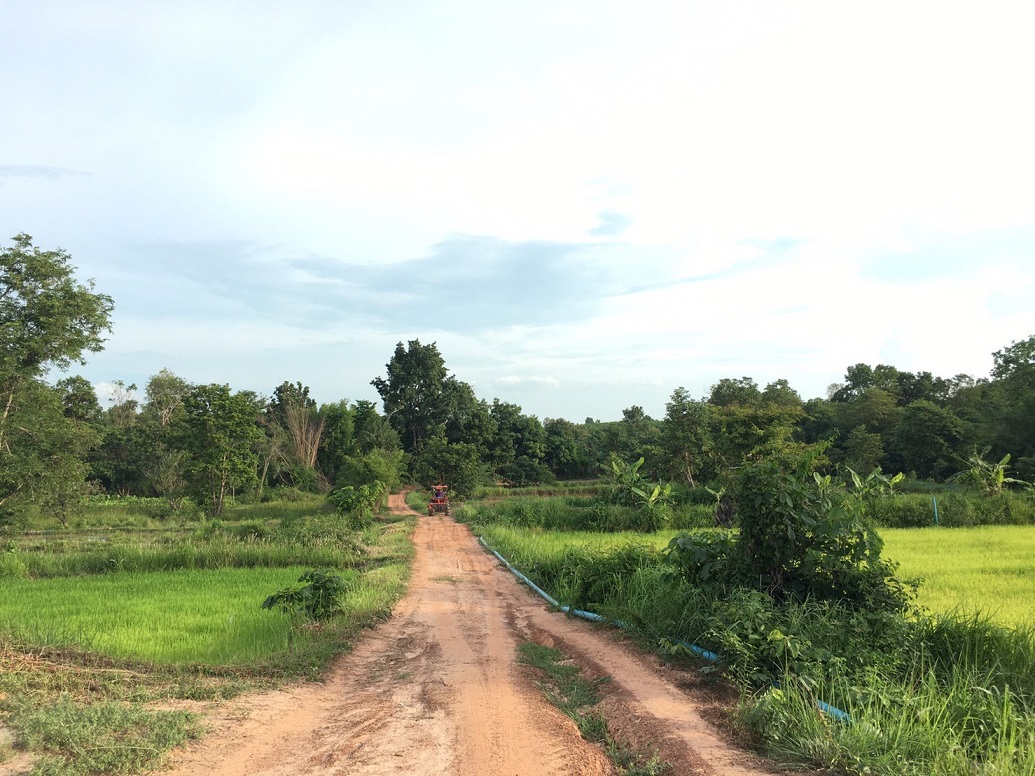

East of Saraburi and the Dongrek Mountain Range, the friendship highway climbs steeply, passing giant lime-stone outcrops and sparsely covered hills before entering a landscape that is harsh, arid and tempered in its beauty. Beyond the town of Pak Chom and the Lam Takhong Reservoir, the mountainous scenery soon gives way to rolling plains, to red sandy soils and to distant hills of KhaonYai which stretch over vast tracks of land towards the Cambodian border.
Here and there, small villages nestle off the high-way, collections of straggling houses and dusty market towns set against a sea of rice and tapioca fields. A few water buffalo languish in the mud, small dots on an endless horizon.
Named after Ishana, the hindu god of death, and occupying the Northeast corner of Thailand, Isaan is the country’s least known region, home to a third of its population and to some of its most extreme and desolate terrain. From the barren soils of the Korat Plateau to the lush table-lands of the Phetchabun Mountain Range, the region covers some 170,000 square kilometers, an intricate canvas of contrasting threads that encapsulates some of the most varied scenery on earth.
Squeezed within these borders is a world that bears little in common with neighbouring regions, a land where the feel of Laos and Cambodia is more prevalent than that of Thaiiland.
The ethnic mix in Isaan has given rise to a different flavour. It is a flavour reflected in their food, their spicy larb Moo and somtam, a fiery salad made from grated unripe papaya, fish sauce, garlic and chillis. It is a flavour reflected in their laguage, a mixture of Lao and Khmer.
More than anything it is a flavour refelcted in their unhurried life style, whith tricyclists snoozing on their bikes in the shade or rice farmers with their wide-brimmed straw hats picknicking in the paddy fields. But the people of Isaan also have an unrivalled zest for life. When Isaan people party, they throw all constraint to the wind, dancing down the streets with their bottles of rice whisky and their sound systems blaring out Isaan’s own distinctive style of music. Even Buddhism, an inextricable part of Isaan life, is by no means inconsistent with enjoyment as when a young man becomes a monk for a period of his life. On such an occasion, the family will invite relatives from miles around. Then a marquee will be put up and vast amounts of alcohol consumed as the people of Isaan indulge themselves in the ultimate release from their days in the fields.
Wherever you travel in Isaan, you will come across tableaus of rural life that come from another age , families bathing in the river of fishing in the rice fields. Indeed, whilst Isaan lacks the beaches and colourful hill tribes of Southern and Northern Thailand, what it offers is far richer and more meaningful : the struggle of human nature over a largely inhospitable envirement.
Isaan people take pride in their culture, in their dialects and their origins. Above all they relish in the absurdity of their position, rebuffing the attacks of cenrtral Thais who regard them as country bump-kins and iliterate farmers.
Beneath the poverty and hardship, however, is a history that not only belittles that of the remaining country, but which may even place Isaan as one of the cradles of civilisation.
According to a well know archaeologists Pisit Charoenwongsa and a group of anthropologists from the university of Pensylvania, between 3,000 BC – 4,000 BC, this area played host to an advanced culture which may have predated that of neighbouring China and Mesopotania. In Ban Chiang and its surrounding villages of Udon Thani Province, magnificent buff pots, bronze tools and burial urns bear witness to a flourishing era of artists and rice farmers. These people not only produced the world’s oldest socketed tool, they may also have traded their expertise with empires as far Flung as Asia Minor where similar finds are evident. Rich carvings too dot the rock faces of Kong Chiam and along the Mekong River. They include images of hunters, fish and animal traps etched with pigment made from animal blood, vegatable gum and soil.
But like many of the most valuable pots and bronze artifacts, these early trumpeters of an advanced civilization disappeared almost without trace, leaving only questions behind them along with thousands of glass beads, necklaces and copper bells.
Outside in the countryside, beyond the factories and the new housing developments, lies the traditional Isaan, a country-side made up of some 20,000 villages, with an estimated three million Lao people and more than half a million Khmers. It is a countryside of rice farmers, of tapioca producers, of salt farms and weavers. More than anything it is a countryside where life remains largely unspoiled by the ever approaching world called progress.
In this forgotten region, the land meanders from one extreme to the other, beautiful and desiccated by turn. From the busy town of Korat, face of the new Isaan, it is a giant leap back in time to the sleepy banks of the Mekong River where the gluttiring brown waters flow down through the northeast, leaving behind a vein of fertility. Along the border, sudden twist and turns in the road offer tantalizing views over to Laos with its gentle backdrop of tatched fishing villages, its lush forests and undulating hills beyond. Occasionally too you may see streams and rapids crisscrossing the rugged slopes, strange fissures etched upon the tropical landsscape.
Any journey to Isaan, however, would be incomplete without a vist to Buriram, Chaiyaphum and Surin wherein lies the heart of Isaan with its rice farmers and cattle herders, its silk weavers, and with its markets piled high with barbecued chicken and sticky rice. This is the place to wander and savour rural life, untouched by the wind of change and to feel for a moment the simple power of times gone by.